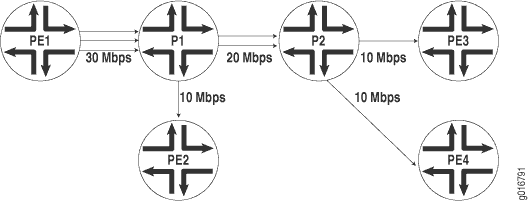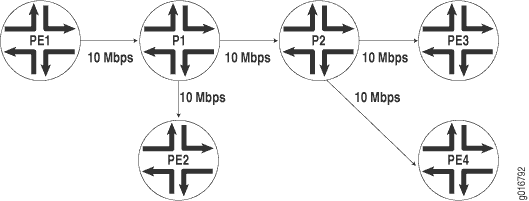Flooding Unknown Traffic Using Point-to-Multipoint LSPs in VPLS
For a VPLS routing instance, you can flood unknown unicast, broadcast, and multicast traffic using point-to-multipoint (also called P2MP) LSPs. By default, VPLS relies upon ingress replication to flood unknown traffic to the members of a VPLS routing instance. This can cause replication of data at routing nodes shared by multiple VPLS members, as shown in Figure 1. The flood data is tripled between PE router PE1 and provider router P1 and doubled between provider routers P1 and P2. By configuring point-to-multipoint LSPs to handle flood traffic, the VPLS routing instance can avoid this type of traffic replication in the network, as shown in Figure 2.


In the VPLS documentation, the word router in terms such as PE router is used to refer to any device that provides routing functions.
The point-to-multipoint LSP used for VPLS flooding can be either static or dynamic. In either case, for each VPLS routing instance, the PE router creates a dedicated point-to-multipoint LSP. All of the neighbors of the VPLS routing instance are added to the point-to-multipoint LSP when the feature is enabled. If there are n PE routers in the VPLS routing instance, n point-to-multipoint LSPs are created in the network where each PE router is the root of the point-to-multipoint tree and includes the rest of the n – 1 PE routers as leaf nodes. If you configured static point-to-multipoint LSPs for flooding, any additional VPLS neighbors added to the routing instance later are not automatically added to the point-to-multipoint LSP. You will need to manually add the new VPLS neighbors to the static point-to-multipoint flooding LSP. If you configure dynamic point-to-multipoint LSPs, whenever VPLS discovers a new neighbor through BGP, a sub-LSP for this neighbor is added to the point-to-multipoint LSP for the routing instance.
This feature can be enabled incrementally on any PE router that is part of a specific VPLS routing instance. The PE routers can then use point-to-multipoint LSPs to flood traffic, whereas other PE routers in the same VPLS routing instance can still use ingress replication to flood traffic. However, when this feature is enabled on any PE router, you must ensure that all PE routers in the VPLS routing instance that participate in the flooding of traffic over point-to-multipoint LSPs are upgraded to Junos OS Release 8.3 or later to support this feature.
To flood unknown unicast, broadcast, and multicast traffic using
point-to-multipoint LSPs, configure the rsvp-te statement
as follows:
rsvp-te { label-switched-path-template (Multicast) { (default-template | lsp-template-name); } static-lsp lsp-name; }
You can include this statement at the following hierarchy levels:
[edit routing-instance routing-instance-name provider-tunnel][edit logical-systems logical-system-name routing-instances routing-instance-name provider-tunnel]
You can configure either a static point-to-multipoint LSP for VPLS flooding or a dynamic point-to-multipoint LSP.
You cannot specify both the static and label-switched-path-template statements at the same time.
The following sections describe how to configure static and dynamic point-to-multipoint LSPs for flooding unknown traffic in a VPLS routing instance:
Configuring Static Point-to-Multipoint Flooding LSPs
The static-lsp option creates a static flooding point-to-multipoint
LSP that includes all of the neighbors in the VPLS routing instance.
Flood traffic is sent to all of the VPLS neighbors using the generated
point-to-multipoint LSP. VPLS neighbors added to the routing instance
later are not automatically added to the point-to-multipoint LSP.
You will need to manually add the new VPLS neighbors to the static
point-to-multipoint flooding LSP. By configuring static point-to-multipoint
LSPs for flooding, you have more control over which path each sub-LSP
follows.
To configure a static flooding point-to-multipoint LSP, specify
the name of the static flooding point-to-multipoint LSP by including
the static-lsp statement:
static-lsp lsp-name;
You can include this statement at the following hierarchy levels:
[edit routing-instances routing-instance-name provider-tunnel rsvp-te][edit logical-systems logical-system-name routing-instances routing-instance-name provider-tunnel rsvp-te]
Configuring Dynamic Point-to-Multipoint Flooding LSPs
To configure a dynamic point-to-multipoint flooding LSP, include
the label-switched-path-template statement option at the [edit routing-instances routing-instance-name provider-tunnel rsvp-te] hierarchy level:
[edit routing-instances routing-instance-name provider-tunnel rsvp-te] label-switched-path-template (Multicast) { (default-template | lsp-template-name); }
You can automatically generate the point-to-multipoint LSP to be used for flooding unknown traffic or you can manually configure the point-to-multipoint LSP:
- Configuring Dynamic Point-to-Multipoint Flooding LSPs with the Default Template
- Configuring Dynamic Point-to-Multipoint Flooding LSPs with a Preconfigured Template
Configuring Dynamic Point-to-Multipoint Flooding LSPs with the Default Template
The default-template option, specified at the [edit routing-instances routing-instance-name provider-tunnel rsvp-te label-switched-path-template] hierarchy
level, causes the point-to-multipoint LSPs to be created with default
parameters. The default parameters are for a minimally configured
point-to-multipoint LSP. The name of this point-to-multipoint LSP
is also generated automatically and is based on the following model:
id:vpls:router-id:routing-instance-name
The following show command output for show mpls
lsp p2mp illustrates how a point-to-multipoint flood LSP name
could appear if you configure the label-switched-path-template statement with the default-template option:
user@host> show mpls lsp p2mp ingress Ingress LSP: 2 sessions P2MP name: static, P2MP branch count: 3 To From State Rt ActivePath P LSPname 10.255.14.181 10.255.14.172 Up 0 * vpn02-vpn11 10.255.14.177 10.255.14.172 Up 0 path2 * vpn02-vpn07 10.255.14.174 10.255.14.172 Up 0 path3 * vpn02-vpn04 P2MP name: 9:vpls:10.255.14.172:green, P2MP branch count: 2 To From State Rt ActivePath P LSPname 10.255.14.177 10.255.14.172 Up 0 * 11:vpls:10.255.14.172:green 10.255.14.174 10.255.14.172 Up 0 * 10:vpls:10.255.14.172:green Total 5 displayed, Up 5, Down 0
The dynamically generated point-to-multipoint LSP name is 9:vpls:10.255.14.172:green.
Configuring Dynamic Point-to-Multipoint Flooding LSPs with a Preconfigured Template
You can configure a point-to-multipoint flooding LSP template for the VPLS routing instance. The template allows you to specify the properties of the dynamic point-to-multipoint LSPs that are used to flood traffic for the VPLS routing instance. You can specify all of the standard options available for a point-to-multipoint LSP within this template. These properties are inherited by the dynamic point-to-multipoint flood LSPs.
To configure a point-to-multipoint LSP template for flooding
VPLS traffic, specify all of the properties you want to include in
a point-to-multipoint LSP configuration. To specify this LSP as a
point-to-multipoint flooding template, include the p2mp and template statements:
p2mp; template;
You can include these statements at the following hierarchy levels:
[edit protocols mpls label-switched-path p2mp-lsp-template-name][edit logical-systems logical-system-name protocols mpls label-switched-path p2mp-lsp-template-name]
For more information about how to configure the p2mp statement and point-to-multipoint LSPs, see the MPLS Applications User Guide.
Once you have configured the point-to-multipoint
LSP template, specify the name of the point-to-multipoint LSP template
with the label-switched-path-template statement:
label-switched-path-template (Multicast) p2mp-lsp-template-name;
You can include this statement at the following hierarchy levels:
[edit routing-instances routing-instance-name provider-tunnel rsvp-te][edit logical-systems logical-system-name routing-instances routing-instance-name provider-tunnel rsvp-te]
